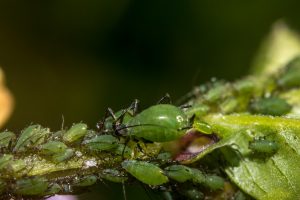Are you a fan of fresh aromatic herbs in your dishes? If so, growing herbs right at home may become your new favorite hobby. In this guide, we’ll delve into how to grow thyme right at home.
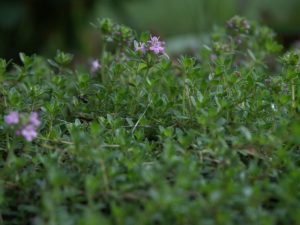
Commonly Grown Varieties
Thyme is a versatile herb known for its earthy flavor and aromatic qualities. It’s a staple in many culinary dishes and adds depth to soups, stews, meats, and vegetables. Not only will thyme have a presence in the kitchen, but it will hold its own in your garden too. And pollinators love thyme too!
Here are some popular varieties of thyme that do well in Central Florida:
- Common Thyme (Thymus vulgaris):
- This variety is known for its classic thyme flavor and fragrance
- USDA Hardiness Zone: 5 to 9
- Growing conditions: Full sun to partial shade with well-draining soil
- Uses: Common thyme is excellent for seasoning meats, poultry, vegetables, and sauces
- Lemon Thyme (Thymus citriodorus):
- Lemon thyme offers a citrusy twist to the traditional thyme flavor
- USDA Hardiness Zone: 5 to 9
- Growing conditions: Full sun to partial shade with well-draining soil
- Uses: Its refreshing lemony aroma makes it perfect for adding to fish dishes, marinades, and salad dressings
- English Thyme (Thymus vulgaris ‘English’):
- English thyme is a robust variety with a slightly sweeter flavor compared to common thyme
- USDA Hardiness Zone: 5 to 9
- Growing conditions: Full sun to partial shade with well-draining soil
- Uses: It’s commonly used in traditional English cooking, including roasts, stuffings, and savory pies
- **Creeping Thyme (Thymus serpyllum):**
- Creeping thyme is a low-growing variety with tiny leaves and a strong fragrance
- USDA Hardiness Zone: 4 to 9
- Growing conditions: Full sun with well-draining soil
- Uses: Its creeping habit makes it perfect for ground cover in rock gardens
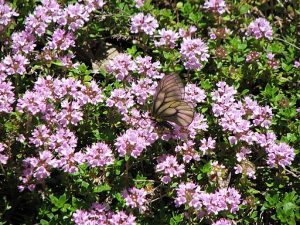
Growing Conditions
To grow thyme successfully in Florida, it is important to know a few things about the plant. Thyme originated in the Mediterranean region, where it is drier than Florida. Thyme can thrive in Central Florida when we accommodate its optimal growing conditions.
Soil Preparation
If you don’t already know your soil conditions, a great place to start is with a soil test. UF/IFAS Extension provides Soil Testing Services that are affordable and available to the public. The results will provide valuable information about your soil’s pH, fertility levels, nutrient content, and how to amend your soil to achieve an optimal pH range for your garden.
Thyme prefers soil that is not too rich or fertile and can tolerate very alkaline soils (which is common in Florida). Thyme does well in alkaline soils with a pH between 6.0 and 8.0. Amend the soil with compost prior to planting to improve drainage and provide some nutrients. Thyme needs low fertility, well draining soil and can tolerate drought once established. This herb is intolerant of wet soils and poor drainage.
Sunlight
Thyme grows best in full sun, so make sure your thyme plants receive at least 6-8 hours of sunlight per day. In Central Florida’s hot subtropical climate, providing some afternoon shade can help prevent the plants from becoming stressed.
Read more about protecting your veggies from the cold here.
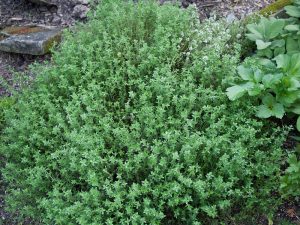
Watering
Thyme is drought-tolerant and relatively low maintenance once established. Water to keep the soil evenly moist and avoid over watering, as thyme plants are susceptible to root rot in waterlogged soil.
Fertilization
Thyme does not require much fertilizer, especially if you amend your soil with compost prior to planting. Thyme prefers low fertility soils, over-fertilizing can lead to reduced flavor in the leaves.
Read more about fertilizers in our Fertilizer Fundamentals series:
- Fertilizer Fundamentals: How to Choose the Right One – UF/IFAS Extension Pasco County (ufl.edu)
- Fertilizer Fundamentals: How to Apply Fertilizer – UF/IFAS Extension Pasco County (ufl.edu)
- Fertilizer Fundamentals: The Best Time to Fertilize – UF/IFAS Extension Pasco County (ufl.edu)
Pests and Diseases
While thyme is relatively pest and disease-resistant, it can still encounter some issues. Here are a few pests and diseases to watch out for:
Pests
- Aphids: These small, soft-bodied insects can cluster on the undersides of leaves, sucking sap and causing wilting. Signs include distorted growth and sticky residue on the foliage. Honeydew is the sticky insect waste (aka: poo) left behind from feeding.
- Treatment: Use a strong jet of water to dislodge aphids from the plant. Spraying insecticidal soap or neem oil will help control their numbers. Always follow the label instructions on the product you use to prevent plant injury.

“Aphid Giving Birth” by Lennart Tange is licensed under CC BY 2.0. To view a copy of this license, visit https://creativecommons.org/licenses/by/2.0/?ref=openverse.
- Treatment: Use a strong jet of water to dislodge aphids from the plant. Spraying insecticidal soap or neem oil will help control their numbers. Always follow the label instructions on the product you use to prevent plant injury.
- Spider Mites: Spider mites are tiny pests that feed on plant sap, causing stippling and webbing on leaves.
- Treatment: Use insecticidal soap or oils to control spider mite populations. If needed, remove and dispose of plants with an infestation.
Diseases
Thyme is prone to fungal diseases such as powdery mildew and root rot, especially in humid conditions. Ensure good air circulation around the plants, so don’t overcrowd them to help prevent these issues.
- Powdery Mildew: Powdery mildew appears as a white, powdery coating on leaves. It can cause leaf distortion and premature leaf drop. It is common in humid in humid conditions, so check your plant for these signs regularly.
- Treatment: To prevent the disease, space your plants out and grow them in a pot or raised bed with well-draining soil to improve air circulation. To treat diseased plants, apply fungicidal sprays containing sulfur or copper to control powdery mildew. Remember, always follow the label instructions on the product.
If the plant has a severe case, remove, and dispose of the sick plant parts to prevent the spread of the disease.
- Root Rot: Root rot is exactly what it sounds like. When plants grow in excessively wet conditions, the roots don’t have enough air, and they begin to rot. These conditions attract fungi and molds that infect the roots and kill the plant they support.
- Treatment: Avoid overwatering and ensure proper drainage around plants. There is no saving a plant with root rot, remove the affected plants and improve soil drainage for the other plants if root rot is detected.
Seasonality
Thyme is a perennial herb that thrives in Central Florida’s winter and spring seasons. You can plant thyme by seed or transplant in late fall or early spring. In colder areas of Central Florida, thyme may die back in the winter but will usually regrow in the spring.

Pruning Thyme for Optimal Growth
Pruning is an essential practice for promoting healthy growth and flavor development in thyme plants. Follow these steps to prune your thyme effectively:
- Identify Growth Points: Thyme is a shrub-like herb. Use sharp scissors or shears to carefully remove the outermost stems. This encourages the plant to redirect energy into growing bushier foliage.
- Prune Regularly: Snip off the outermost stems as needed to promote new growth. Avoid cutting more than one-third of the plant at a time. Use fresh thyme leaves and flowers in cooking or store them for later use.
- Remove Flower Buds: As thyme matures, it may produce small pink or purple flowers. These flowers add a pop of color to your garden, and the pollinators love them! For culinary purposes, it’s best to pinch off the flower buds as soon as they appear(and eat them – they’re also edible!). This encourages the plant to focus on producing flavorful leaves rather than flowers.

How to Harvest and Store Thyme
Harvest thyme leaves as needed throughout the growing season, being careful not to over-harvest. A good rule of thumb is to keep at least 5 inches of the plant intact. Aim to prune it in early spring and summer, and harvest thyme just before it flowers. At this time, the essential oil content in the leaves is at its peak.
To store harvested thyme, place the stems in a container of water away from direct sunlight for immediate use. For longer storage of this hardy herb, wrap the leaves with moist paper towels and store them in the refrigerator. Alternatively, you can freeze the cuttings or dry them to create your own seasoning.
Tips for the Floridian Gardener
Here are some additional tips for growing thyme in Central Florida’s subtropical climate:
- Select Heat-Tolerant Varieties: Choose thyme varieties that can withstand the region’s high temperatures and humidity. Varieties like Common Thyme and Lemon Thyme are well-suited for Central Florida.
- Conscious Planting: Plant thyme during the cooler months of fall and winter to minimize stress from intense sunlight. Providing afternoon shade can also help protect the plants.
- Mulch and Water Wisely: Apply mulch around thyme plants to retain moisture and regulate soil temperature, especially during dry spells and heatwaves. Water thyme occasionally. You can allow the soil to dry completely between waterings.
- Monitor for Pests and Diseases: Keep an eye out for common pests and diseases. Inspect the top and bottom of foliage regularly and take proactive measures to prevent infestations and diseases.
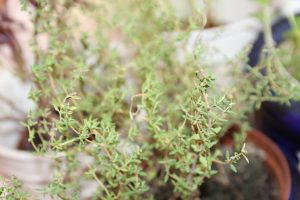
Conclusion
Growing thyme in Central Florida is rewarding, adds culinary versatility to your dishes, and attracts pollinators to your garden. By using these tips, you can cultivate a thriving thyme garden right at home. Also, leave a few plants for the pollinators to enjoy! Happy gardening!
Read the series:
- Spice Up Your Life: A Beginner’s Guide to Growing Marjoram
- Spice Up You Life: A Beginners Guide to Growing Sage
- Spice Up Your Life: A Beginners Guide to Growing Lavender
- Spice Up Your Life: A Beginners Guide to Growing Thyme
- Spice Up Your Life: A Beginners Guide to Growing Chives
- Spice Up Your Life: A Beginners Guide to Growing Dill
- Spice Up Your Life: A Beginners Guide to Growing Oregano
- Spice Up Your Life: A Beginners Guide to Growing Parsley
- Spice Up Your Life: A Beginners Guide to Growing Basil
Have a question?
If you have any questions about gardening in Central Florida, please contact the UF/IFAS Extension Pasco County at 352-518-0156. For more information on UF/IFAS Extension Pasco County Community Gardens, and how you can join one, visit http://sfyl.ifas.ufl.edu/pasco/. Supervising agent: Dr. Whitney Elmore.
Follow us!
We have several ways to connect. Visit our Facebook, Instagram, Eventbrite, Blogs, Florida-Friendly Facebook, & Website.
Visit our page for more tips and tricks on maintaining a home garden!
 5
5
